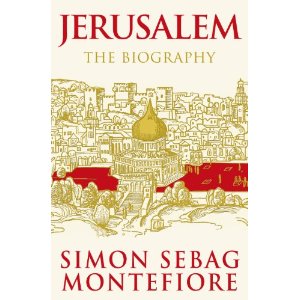Next Year in Jerusalem!
Mini Teaser: Simon Sebag Montefiore’s tour through Jerusalem demonstrates that the conquerors of history saw this city as a treasure worth countless lives. The current face-off between Israelis and Palestinians is only the latest intractable conflict.
MONTEFIORE HAS a wonderful eye for anecdote and quotation. (These have served him well, and comparably, in his best-selling books on Stalin’s Russia. Jerusalem was a best seller in Britain for weeks.) And these, deftly handled, easily hold the reader’s attention as he wades through this fulsome text which spans over six hundred pages and three thousand years. Here and there, wit too obtrudes. Take the following, about Egypt’s Ptolemaic dynasty (it appears in a footnote, where one often encounters interesting digressions):
Even by the family’s vicious standards, Ptolemy VIII Euergetes, nicknamed Fatso (Physkon) by the Alexandrian mob, was a monster. . . . The climax of his cruelties was the murder of his own fourteen-year-old son who totally trusted his father: Fatso had the boy’s head, legs and hands cut off and sent to his own mother, Cleopatra II. When another of the family, Cleopatra Thea . . . decided to murder her own son, she offered him a cup of poison. But the son forced the mother to drink it. Such was family life among the Ptolemies.
Moving on in the centuries, Montefiore quotes the striking description by Imad al-Din, Saladin’s secretary, of the enemy Richard the Lionheart’s camp outside Acre in northern Israel, which he visited in 1191 (the combatants through the ages often indulged in parley and limited truce). Actually, he appears to have been captivated by the camp followers rather than the cantonment itself. Imad, by his own account, ogled the “singers and coquettes, tinted and painted, blue-eyed with fleshy thighs,” who
plied a brisk trade, brought their silver anklets up to touch their golden earrings, invited swords to sheath, made javelins rise toward shields, gave birds a place to peck with their beaks, caught lizard after lizard in their holes, [and] guided pens to inkwells.
This passage, like many others in the book, raises a serious point about balance: Montefiore often—and at length—describes the violent episodes and sexual escapades and peccadilloes that dotted Jerusalem’s history or characterized the town’s protagonists. Without doubt, these, as with violence and sex in movies and literary fiction, help rope in the customers and maintain their interest. At times, certainly, Montefiore’s stories are apt and historically enlightening, as when he tells us about the hanky-panky between Katy Antonius, wife of Palestinian nationalist and historian George Antonius, and General Sir Evelyn “Bubbles” Barker, the commanding officer of Britain’s army in Palestine during the waning years of the British mandate. Barker famously had ordered his troops, under frequent attack by gunmen of the Zionist terrorist/guerrilla organizations the IZL (the Irgun) and LHI (the Stern Gang), to punish by boycott “the Jews in a way the race dislikes as much as any, by striking at their pockets.” In a letter to his lover, Barker called Jews “loathsome people” (the letter lamely ended, “Katy, I love you so much”).
But occasionally one senses that sex and violence are being given too much play and that the space allocated could have been better used to other ends.
A more serious fault is the author’s occasional sloppiness when it comes to facts. Just to peek at the period I am most familiar with (the first Arab-Israeli war), Montefiore has the famous Mount Scopus ambush, in which a convoy delivering supplies and personnel to Hadassah Hospital was attacked and some seventy Jewish doctors and nurses died at the hands of Arab irregulars, take place on April 14 (actually, it was on April 13). And it is not true that “the [Jewish supply] convoys broke through” to besieged Jerusalem on “15 April” (actually at least one got through earlier). Montefiore tells us too that in November 1947, Arabs owned “94 per cent of the land [surface]” of Palestine. Yet, it was closer to 30 percent; the Jews owned some 6–7 percent, and the government “owned” the remainder in one form or another (parks and forests, unregistered desert areas, road and railway tracts, military camps, firing ranges, etc).
“Half the Egyptian forces” battling the Israelis from May 15, 1948, he writes, “were mujahidin of the Muslim Brotherhood.” But, the percentage of fundamentalist civilian volunteers was much, much smaller (no more than 10–20 percent, if that). Montefiore calls the British representative in Amman Sir Alec Kirkbridge; it should be Kirkbride. He tells us that Israel signed armistice agreements “with all five of the Arab states”—it signed pacts with only four, and there were more than five Arab states in 1949. He has General Sir John Glubb being ousted by King Hussein of Jordan from the command of the Arab Legion, Jordan’s army, “soon after” the 1956 Sinai/Suez war, while that occurred before the battle, in March of that year.
Perhaps this is inevitable in a volume that covers so much, with its vast chronological reach and multitudinous cast of characters: Who can properly know such an extensive period in great detail? Still, a good, knowledgeable editor would have been useful.
In the end, all of this is of minor importance. There is no and cannot be a definitive “biography” of Jerusalem, as there is no definitive religion. But Montefiore’s take can well serve as a fine, generally reliable, highly entertaining introduction to the city’s history.
Pullquote: The real problem in peacemaking is one of mutual trust, which decades of Arab suicide bombing and Israeli rule and oppression have undermined (perhaps definitively).Image: Essay Types: Book Review
Essay Types: Book Review 